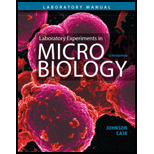
Concept explainers
What is the advantage of using Petri plates rather than test tubes in
To analyze:
The advantage of Petri dishes over test tubes in microbiology.
Introduction:
Microbiology is a discipline of studying microscopic organisms like protozoa, fungi, archaea, viruses, and bacteria for different aspects. The field of study has many applications in industry and research. Microbes that are beneficial for humans are cultured at a larger level for extracting their benefits whereas the ones harmful to humans are studied to combat their harmful effects.
Explanation of Solution
A petri dish is a transparent dish that is shallow and lidded. It is commonly used for culturing microorganisms like small mosses and bacteria.
A test tube or a culture tube is a finger-like tube commonly used in laboratories. It is open from the top and closed from the bottom. Test tubes can be made from plastics or glass. It is used for culturing and handling different types of live organisms such as plant cuttings, seedlings, bacteria, etc.
Petri dishes are beneficial over test tubes as they provide a larger surface area for culturing. Also, culturing and assaying of microbes can be done in different and easy ways. Colonies of microorganisms can be easily isolated and counted in a petri dish.
Petri dishes are beneficial over test tubes as they provide a larger surface area for microbial growth and allows a biologist to examine the culture easily.
Want to see more full solutions like this?
Chapter 3 Solutions
Laboratory Experiments in Microbiology (12th Edition) (What's New in Microbiology)
- Which of the follwowing cells from this lab do you expect to have a nucleus and why or why not? Ceratium, Bacillus megaterium and Cheek epithelial cells?arrow_forward14. If you determine there to be debris on your ocular lens, explain what is the best way to clean it off without damaging the lens?arrow_forward11. Write a simple formula for converting mm to μm when the number of mm's is known. Use the variable X to represent the number of mm's in your formula.arrow_forward
- 13. When a smear containing cells is dried, the cells shrink due to the loss of water. What technique could you use to visualize and measure living cells without heat-fixing them? Hint: you did this technique in part I.arrow_forward10. Write a simple formula for converting μm to mm when the number of μm's are known. Use the variable X to represent the number of um's in your formula.arrow_forward8. How many μm² is in one cm²; express the result in scientific notation. Show your calculations. 1 cm = 10 mm; 1 mm = 1000 μmarrow_forward
- Find the dental formula and enter it in the following format: I3/3 C1/1 P4/4 M2/3 = 42 (this is not the correct number, just the correct format) Please be aware: the upper jaw is intact (all teeth are present). The bottom jaw/mandible is not intact. The front teeth should include 6 total rectangular teeth (3 on each side) and 2 total large triangular teeth (1 on each side).arrow_forwardAnswer iarrow_forwardAnswerarrow_forward
- calculate the questions showing the solution including variables,unit and equations all the questiosn below using the data a) B1, b) B2, c) hybrid rate constant (1) d) hybrid rate constant (2) e) t1/2,dist f) t1/2,elim g) k10 h) k12 i) k21 j) initial concentration (C0) k) central compartment volume (V1) l) steady-state volume (Vss) m) clearance (CL) AUC (0→10 min) using trapezoidal rule n) AUC (20→30 min) using trapezoidal rule o) AUCtail (AUC360→∞) p) total AUC (using short cut method) q) volume from AUC (VAUC)arrow_forwardQUESTION 8 For the following pedigree, assume that the mode of inheritance is X-linked recessive, and that the trait has full penetrance and expressivity and occurs at a very low frequency in the hum population. Using XA for the dominant allele and Xa for the recessive allele, assign genotypes for the following individuals (if it is not possible to figure out the second allele of a genotype, that with an underscore): 2 m 1 2 1 2 4 5 6 7 8 9 IV 1 2 3 5 6 7 8 CO 9 10 12 13 V 1, 2 3 4 5 6 7 8 9 10 11 12 13 a. Il-1: b. 11-2: c. III-3: d. III-4: e. If individuals IV-11 and IV-12 have another child, what is the probability that they will have a boy with the disorder?arrow_forwardAnswerrarrow_forward
 Principles Of Radiographic Imaging: An Art And A ...Health & NutritionISBN:9781337711067Author:Richard R. Carlton, Arlene M. Adler, Vesna BalacPublisher:Cengage Learning
Principles Of Radiographic Imaging: An Art And A ...Health & NutritionISBN:9781337711067Author:Richard R. Carlton, Arlene M. Adler, Vesna BalacPublisher:Cengage Learning- Essentials Health Info Management Principles/Prac...Health & NutritionISBN:9780357191651Author:BowiePublisher:Cengage





